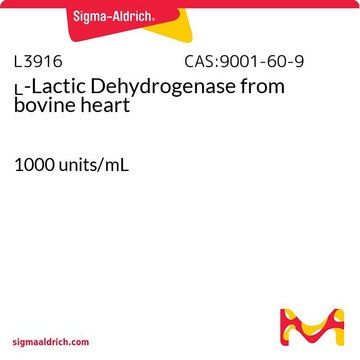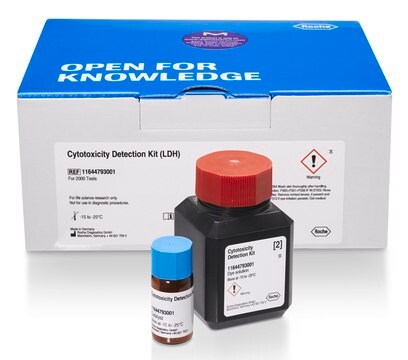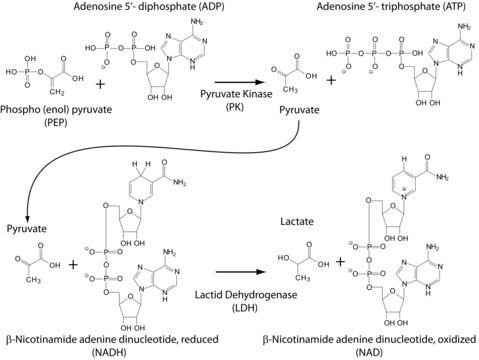LLDH-RO
Roche
L-Lactate Dehydrogenase (L-LDH)
About This Item
Produits recommandés
Source biologique
rabbit muscle
Niveau de qualité
Forme
suspension
Activité spécifique
~550 units/mg protein (at 25 °C (1,100 U/mg at 37 °C) with pyruvate as the substrate.)
Poids mol.
140,000 Da
Conditionnement
pkg of 10 mL (10127884001 [100 mg])
pkg of 2 mL (10127230001 [10 mg])
pkg of 5 mL (10127876001 [25 mg])
Fabricant/nom de marque
Roche
Technique(s)
activity assay: suitable
Couleur
white
pH
6.0-7.0
Solubilité
water: miscible
Numéro d'accès NCBI
Numéro d'accès UniProt
Application(s)
life science and biopharma
Activité étrangère
Aldolase <0.001%
GOT <0.01%
GPT <0.01%
MDH <0.01%
PK <0.001%
myokinase <0.01%
Conditions d'expédition
wet ice
Température de stockage
2-8°C
Informations sur le gène
rabbit ... LOC100355262(100355262)
Description générale
L-lactate dehydrogenase catalyzes the reversible reduction of pyruvate to L-lactate.
Spécificité
Application
Séquence
Therefore, 5 electrophoretically distinguishable LDH isoenzymes, LDH-1 through LDH-5, of differing subunit composition, are found in mammals.
The molecular weight of all LDH isoenzymes is approximately the same.
– LDH-1 (H4), LDH-2 (H3M): predominant components of heart LDH
– LDH-3 (H2M2): principal component of LDH from lymphatic tissue
– LDH-4 (HM3), LDH-5 (M4): predominate in skeletal muscle or liver LDH
Note: The M subunit of LDH used to be designated the A subunit; the H subunit was the B subunit. Under the old designation, LDH-1 isoenzyme was LDH-B4.
Définition de l'unité
Note: For preparations H and I, the activity is defined at +30 °C, pH 7.8. The above assay consumes 1 mol of NADH per mol of pyruvate reduced.
Unit Conversion: For the reduction reaction, pyruvate as substrate:
1 U (+25 °C) 1.5 U (+37 °C) [hog muscle LDH in glycerol].
1 U (+25 °C) 1.8 U (+37 °C) [hog muscle LDH in amm onium sulfate].
1 U (+25 °C) 1.1 U (+30 °C) 2.0 U (+37 °C) [rabbit muscle LDH].
1 U (+25 °C) 1.4 U(+30 °C) 2.5 U (+37 °C) [pig heart LDH].
1 U (+25 °C) 2.5 U (+37 °C) [beef heart LDH].
Forme physique
Notes préparatoires
Remarque sur l'analyse
Autres remarques
Code de la classe de stockage
12 - Non Combustible Liquids
Classe de danger pour l'eau (WGK)
WGK 1
Point d'éclair (°F)
does not flash
Point d'éclair (°C)
does not flash
Certificats d'analyse (COA)
Recherchez un Certificats d'analyse (COA) en saisissant le numéro de lot du produit. Les numéros de lot figurent sur l'étiquette du produit après les mots "Lot" ou "Batch".
Déjà en possession de ce produit ?
Retrouvez la documentation relative aux produits que vous avez récemment achetés dans la Bibliothèque de documents.
Les clients ont également consulté
Notre équipe de scientifiques dispose d'une expérience dans tous les secteurs de la recherche, notamment en sciences de la vie, science des matériaux, synthèse chimique, chromatographie, analyse et dans de nombreux autres domaines..
Contacter notre Service technique













